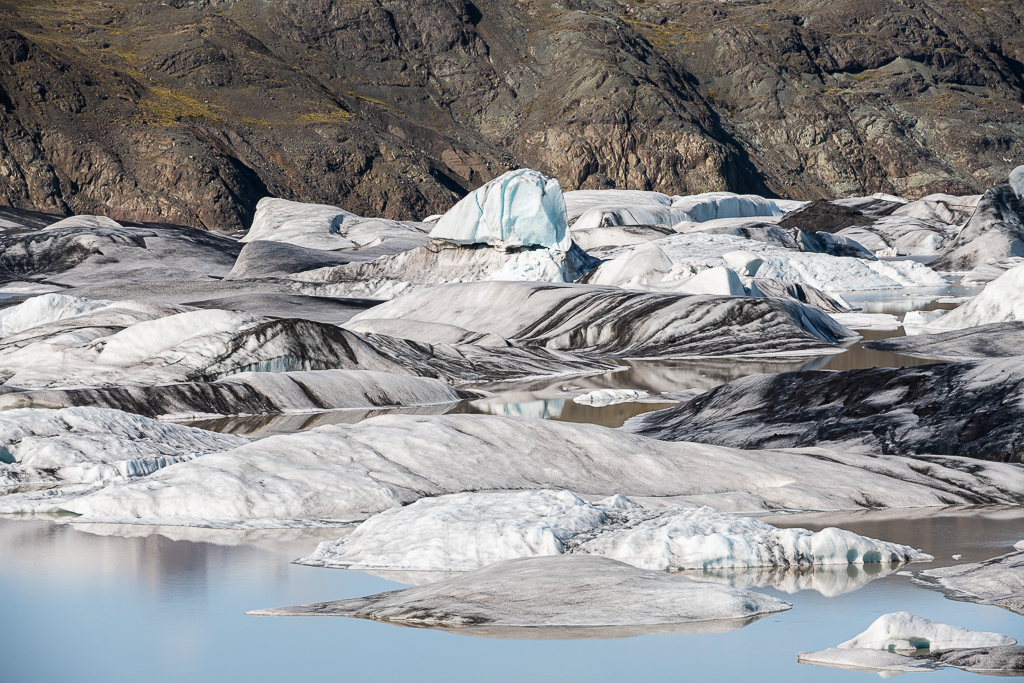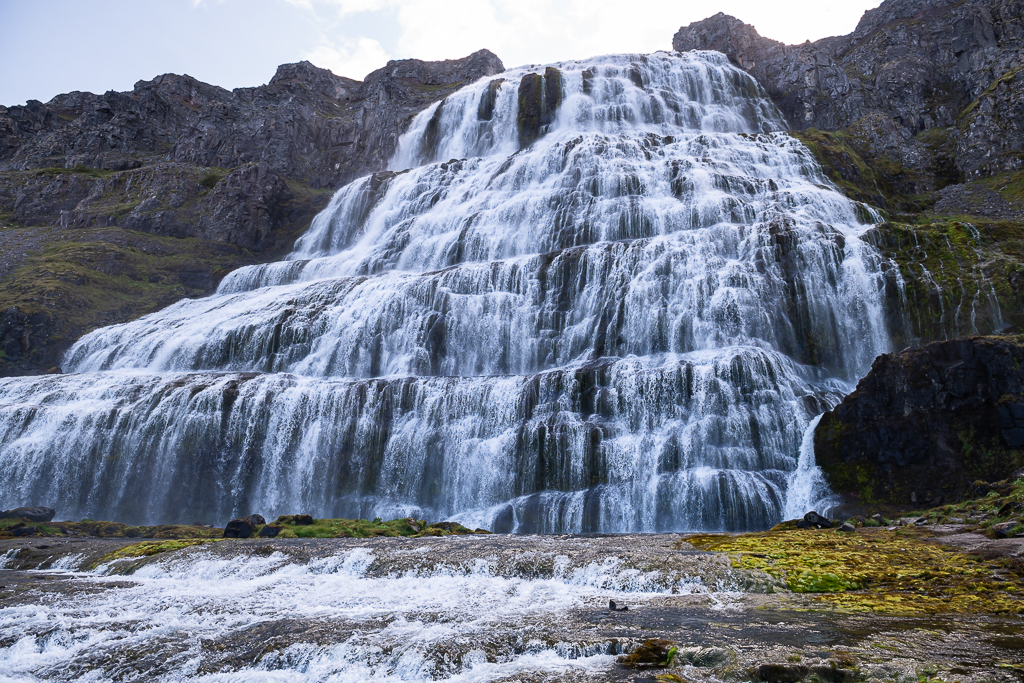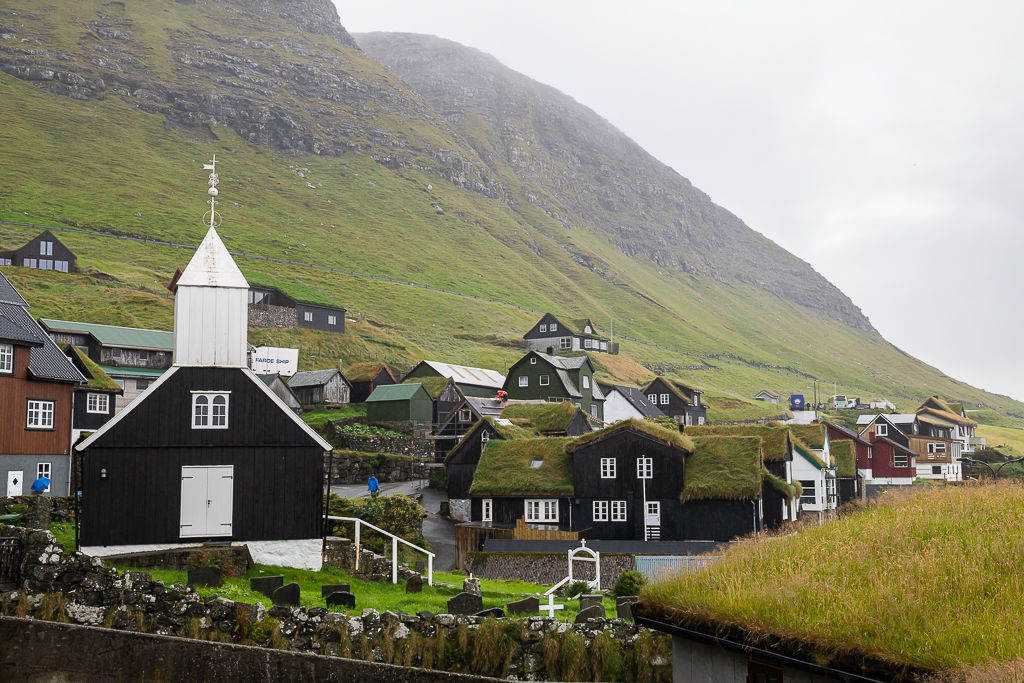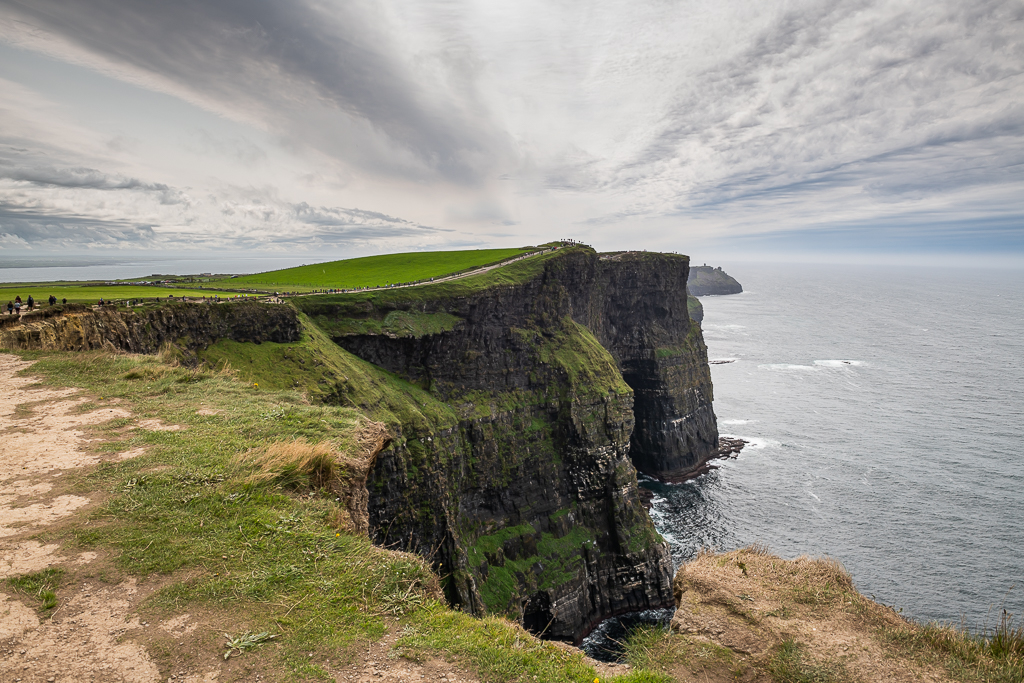Iceland: The Land of Fire and Ice – 2018
Iceland – The Land of Fire and Ice – may not be the first place that springs to mind for a cruise, but in many ways it is the perfect voyage – allowing unprecedented views of this diverse and beautiful landscape.
You can watch from the decks as you sail by towering mountains of ice, spectacular fjords, stunning waterfalls, geysers, some of the world’s most active volcanoes, black sand beaches, and steaming lava fields – reminiscent of an almost alien landscape.



The most common way to see Iceland is to drive the Ring Road, a 2,100 mile route encircling the country – but it doesn’t go anywhere near where a small cruise ship can sail.
And it is far cheaper by cruise ship. Icelandic hotels, restaurants and rental cars are among the most expensive in the world. I had a Eureka moment when I calculated an Icelandic cruise would more than halve the price of a land-based trip.
And anyway, our agile, 800-passenger ship – the Prinsendam – the smallest vessel owned by Holland America, took the road less travelled, because our access points often came through dockside mooring in small fishing towns.
“We’re getting access to a lot of places that you wouldn’t be able to get to via the road systems,” said a Holland America spokesperson. “We’re off exploring for full days, enjoying the destination and then we come back to our floating hotel.”
We actually circumnavigated the entire country, including sailing north of the Arctic Circle.
And as we sailed around the country, Rose Kay’s beautiful poem, Iceland, went through my head on many occasions.
How magnificently you were born
Under brilliant Northern lights
Rising above the sea
With Black beaches
Electric blue waters
And Forever cascading waterfalls
Great Danes of long ago
With Ancient wisdom
Mightier than Gods of old
Brought to your shores
Powerless under your mighty volcanoes
Bowed their heads upon your site
How wondrous you are
Surrendering to your beauty
A secret they kept you
exquisitely they named you
Land of Ice.
We first set foot on the shore of Iceland at Djupivogur, in the southern pocket of East Iceland, where life moves at an unhurried pace.
Dominating the landscape is the pyramid-shaped peak named Búlandstindur, reaching over 3,000 feet. According to legend, it can make wishes come true during the summer solstice; others believe it has supernatural powers.
We visited Vatnajokull Glacier, Europe’s largest glacier, with a majestic, deep glacial lagoon in its wake. It was truly breathtaking but clearly illustrated the effects of global climate change as the glacier has retreated dramatically over the past few years.


Akureyri was always high on my bucket list.
Akureyri is the little big city of Iceland. It‘s easy to be fascinated by Akureyri with it‘s with brightly painted wooden houses, cosy bars and steep streets leading down from the hills into the city centre. With a population of only 19,000, it is a warm, friendly city sure to make you smile.
Even the traffic lights are cool, with stop lights in the shape of red hearts. These were installed after the financial crash in 2008 to brighten the general mood of the population.
Akureyri is also a great base for adventures to many of Iceland’s most beautiful natural wonders, such as waterfalls, volcanic areas and canyons.
We drove along Iceland’s longest fjord, Eyjafjordur, looking back at spectacular views of Akureyri. Then through the Fnjoskadalur Valley to Godafoss falls (Waterfalls of the Gods), thundering dramatically across the rugged and majestic landscape.




We loved the tranquillity of Lake Mývatn, the colours of the Grjótagjá geothermal cave pool and the sculpture-like rock formations of the Dimmuborgir lava fields with tower lava castles and arches, and finally the sulfur cauldrons in the geothermal field of Namaskard.
The weather was beautiful throughout the entire trip and one of the most sparkling days was in Isafjordur the largest settlement in the Westfjords of Iceland surrounded by landscapes of jagged peaks and narrow mountain ridges.
The climate of the Westfjords and Isafjördur is tundra, bordering closely on subarctic, meaning the winters are cold and the summers cool.
The oldest house still standing in Iceland, built in 1734, is located in Isafjördur as part of the local folk museum. The area also includes the most extensive body of old timber frame houses in the country, constructed in the 18th century by foreign traders.
It was here that we took a bus trip over the switchback roads to visit the Dynjandi Falls featuring an upper cascade and tiered terraces with a freefall into the pool below. It was an hour climb to the cascade, but well worth the effort.



Finally we arrived in vibrant Rejkavik. It is, incidentally, the only Western European capital without a Starbucks or a McDonald’s! And it is the northernmost capital of a sovereign state in the world and is among the cleanest, greenest, and safest cities anywhere.
Hallgrimskirkja church, with its height of 244 feet, is the largest church in Iceland and one of its tallest structures. It is visible from everywhere in the city as it sits at the top of a small hill. Hallgrímskirkja is a Lutheran parish church, often mistaken for a cathedral, designed to resemble the rocks, mountains and glaciers of Iceland.




The word Reykjavík translates literally as “smoky bay”. The name refers to the steam that used to rise from the hot springs and geothermal vents.
Iceland’s capital city is also a terrific base from which to experience some of the island’s breathtakingly beautiful natural wonders, such as the famous Blue Lagoon geothermic spa, The Northern Lights and the Golden Circle, where you’ll witness spouting geysers, waterfalls, and rift valleys.
From Reykjavik we took a drive drive over Mostfellsheidi Heath to Thingvellir National Park, a UNESCO world heritage site.
The tour of the Golden Circle showed off the Icelandic landscape in all its glory. Craggy lava fields and ice-dappled mountains provided a splendid backdrop to tapestries of purple lupins and billowing fumaroles. The air was as clear as the roads – 85 per cent of the nation’s houses are heated with geothermal energy, according to our guide.
We witnessed the raw power of mighty Gullfoss – the Golden Waterfall – (perhaps the most spectacular waterfall I have ever seen) before strolling through the rift in the Mid-Atlantic Ridge in Thingvellir National Park, where the North American and Eurasian tectonic plates have pulled apart. Iceland’s first parliament was formed here more than 1,000 years ago.

We followed our noses to Geysir’s rotten-egg-smelling sulphur springs and bubbling mud pools, and Strokkur Geyser, which ejected a 75ft column of boiling water intermittently. The earth’s crust here is as delicate as an eggshell.
The final stop on our Iceland tour was Heimaey, the largest of the Westman Islands and the only one inhabited. The city is built between two volcanoes including Eldfell, site of the 1973 volcanic eruption.
The eruption was catastrophic. Amazingly, no-one died, but 400 homes and businesses were destroyed.

More Atlantic Puffins nest here than anywhere else in the world. To see nesting puffins, the best place is without a doubt Storhofoi, the ‘Great Cape’ on the southern side of Heimaey. There is a lookout point, and several paths where you can walk along the cliffs for better views.
While Iceland was the focus of the trip, the cruise also took us to Torshaven in the Faroe Islands, the Shetlands and even Edinburgh for the Royal Tattoo, where I celebrated my 68th birthday within the walls of Edinburgh Castle.
The Faroe Islands are an archipelago between the Norwegian Sea and the North Atlantic Ocean, approximately halfway between Norway and Iceland.
On the Faroe Islands, there are houses with grass roofs that seem like an abandoned Hobbit movie set, when in fact these picturesque and lush settings are ancient dwellings.
In Faroe Island, it rains 300 days during the year – and indeed it absolutely poured the day we were there – so the settlers introduced the grass roofs as it provided protection from the constant rain and thermal insulation. During the Viking and Middle Ages most houses had sod roofs. In rural areas sod roofs were almost universal until the beginning of the 18th century.


We also visited the Church of the Faroe Islands, which is the smallest state church in the world and much of the structure had a nautical flavour given the inhabitants of the area are seafaring people.
Sod or turf for roofing was cut from good pasture land, preferably with sandy soil. A naturally grown grass with a deep root system was desirable.The turf was cut into portable pieces, each about one foot square and about 3 inches thick, half the thickness of the finished covering.
Lerwick in the Shetland Islands, was equally fascinating. The Shetland Islands are the location of the award winning crime British tv series “Shetland”.

Lerwick is Shetland’s only town, and Britain’s most northerly, with a population of about 7,500 – although about half of the islands’ 22,000 people live within 10 miles of the burgh.
The old waterfront is thronged with pleasure boats, visiting yachts, historic craft and working fishing boats.
Most of the sandstone buildings on the waterfront date from the 18th century. The charming narrow main street still follows the old shoreline but modern harbour works have been built out in front of shops and warehouses that once stood in the sea.
And while FairIsle Knitwear is what the Shetland is primarily known for the islands are one of the few places in the world where wool has been continuously “grown” , processed, knitted and sold for centuries – my wife bought what she said was the most beautiful traditional sweater ever.
The cruise started and finished in Amsterdam, so we had several days there exploring before and after setting sail.
And I couldn’t resist a quick flight from there to add one more country to my list – Liechenstein.
I flew there from Amsterdam, via Zurich. As you stand on the border with Switzerland there are only a couple of flags and a boulder – on my left rise the snow-capped peaks of the Swiss Alps, to my right those of Austria: two mountainous arms encircling the tiny principality.
The country is only 15.5 miles long. I spotted the turrets of Gutenberg Castle – one of two surviving castles originally built in the Middle Ages when Liechtenstein was a part of the Holy Roman Empire.
It became a country in its own right in 1719 when Emperor Charles VI united the areas of Schellenberg and Vaduz and elevated them to the status of principality. Thus Liechtenstein, which literally means “light stone” was born, amid some scepticism about the ability of a country so small to survive. It has not only survived but prospered – one of the smallest countries in Europe is now also one of the richest.
Government here is fairly low-key. There are just 25 parliamentarians who meet on average once a month.
It was only when the government decided to reduce taxes and create a haven for foreign investors that it was transformed into a centre for banking and industry.
Before returning to Amsterdam there was enough time to explore Zurich before catching my flight back. With the historic tower of St Peter Kirche dominating the skyline, its clock face the largest in Europe, this is a beautiful old city of water and bridges.
Also, from Amsterdam, we took a day trip to Bruges, Belgium.




Bruges is a medieval city – a fascinating marriage of old and new. The UNESCO World Heritage site is hailed as the Venice of the North for its comprehensive system of canals.
We spent a day wandering the city’s enchanting cobblestone streets and traversing its waterways and it didn’t take long to understand why Bruges needs to be on every traveler’s bucket list.
Bruges’s main square, or Markt, is the crown jewel of the city, a preserved medieval centre that was once the location for everything from celebrations to executions.
Bruges is home to some astounding churches containing precious art, interesting designs, and holy relics. The Basilica of the Holy Blood famously houses a vial of Jesus’s blood. The Madonna of Bruges, Michelangelo’s incredible statue depicting Mary and Jesus, can be found at the Church of Our Lady.
Jeruzalemkapel was built during the 15 century and is renowned for its spooky and intriguing decorations. The whole church is festooned with skulls. Saint Salvator’s Cathedral is the oldest church in Bruges and is full of medieval treasures and relics.
For our entire trip we used Dublin as our starting off and finishing point, flying directly there and back from Canada. It was four of the best days we’ve spent travelling anywhere in the world.
As an aside we stayed at the Schoolhouse Hotel, literally a converted schoolhouse. It was close enough to walk to the city centre, but provided comfortable, quiet rooms and excellent Irish food – with the biggest breakfast I have ever seen.
Gregarious, energetic Dublin has turned its face to the world ever since the Vikings established a trading settlement here in the ninth century.
Today, it continues as a vibrant urban centre and a developing international transport hub, as well as a European national capital with a cultural infrastructure to match.
Like most visitors we made for the Temple Bar district, with its narrow cobbled streets and cluster of cultural attractions: but don’t miss the city’s classical Georgian squares and terraces, its regenerating docklands – and the fine seaside sweep of Dublin Bay, with its harbours, cliff walks, wide skies and bracing air.
But our favourite site was EPIC the Irish Emigration Museum. Not to be missed – it is one of the most beautifully setup museums in the world. 2020 – and was winner of Europe’s Leading Tourist Attraction at the World Travel Awards 2019. And don’t miss the stunning and touching famine sculptures just outside.
We also took a train out to the Cliffs of Moher on the westernmost edge of Ireland, the rugged Cliffs of Moher tower almost 700 feet above sea level.


Considered by many to be the absolute best place to visit in Ireland, this jagged coastline stretches for five miles along the ocean.
When not shrouded by thick, gray fog and sheets of rain, it’s possible to see as far west as the Aran Islands – the view from the top is one of the most iconic in the world.
We also went up to Belfast. We skipped the Titanic Museum – who would build a museum to a failed ship? Speaks volumes about the Irish! Instead we took a never to be forgotten journey in a traditional black taxi. Our driver explained the religious divide in Ireland more clearly that anything I have heard before.
The 90-minute tour included a drive through Falls Road (Catholic) and Shankill Road (Protestant), past political wall murals, the peace lines keeping Protestants and Catholics apart, plus around the docks and the university area.
The driver – a former member of the IRA – like cabbies everywhere, offered a pithy and informative commentary on where it all went wrong, and how to get it right.


And our trip ended with several hours in pouring rain climbing over the 40,000 interlocking basalt columns of the Giants Causeway, the result of an ancient fissure eruptions.It is located in County Antrim on the north coast of Northern Ireland and declared a UNESCO World Heritage Site in 1986.


The tops of the columns form stepping stones that lead from the cliff foot and disappear under the sea. Most of the columns are hexagonal, although there are also some with four, five, seven or eight sides.[6] The tallest are about 40 feet high, and the solidified lava in the cliffs is 90 feet thick in places.
Writing this I realize it was a remarkable trip. Perhaps this Irish blessing sums up the total trip best:
“May the road rise up to meet you, may the wind be always at your back. May the sun shine warm against your face, and the rains fall soft upon your fields.”





